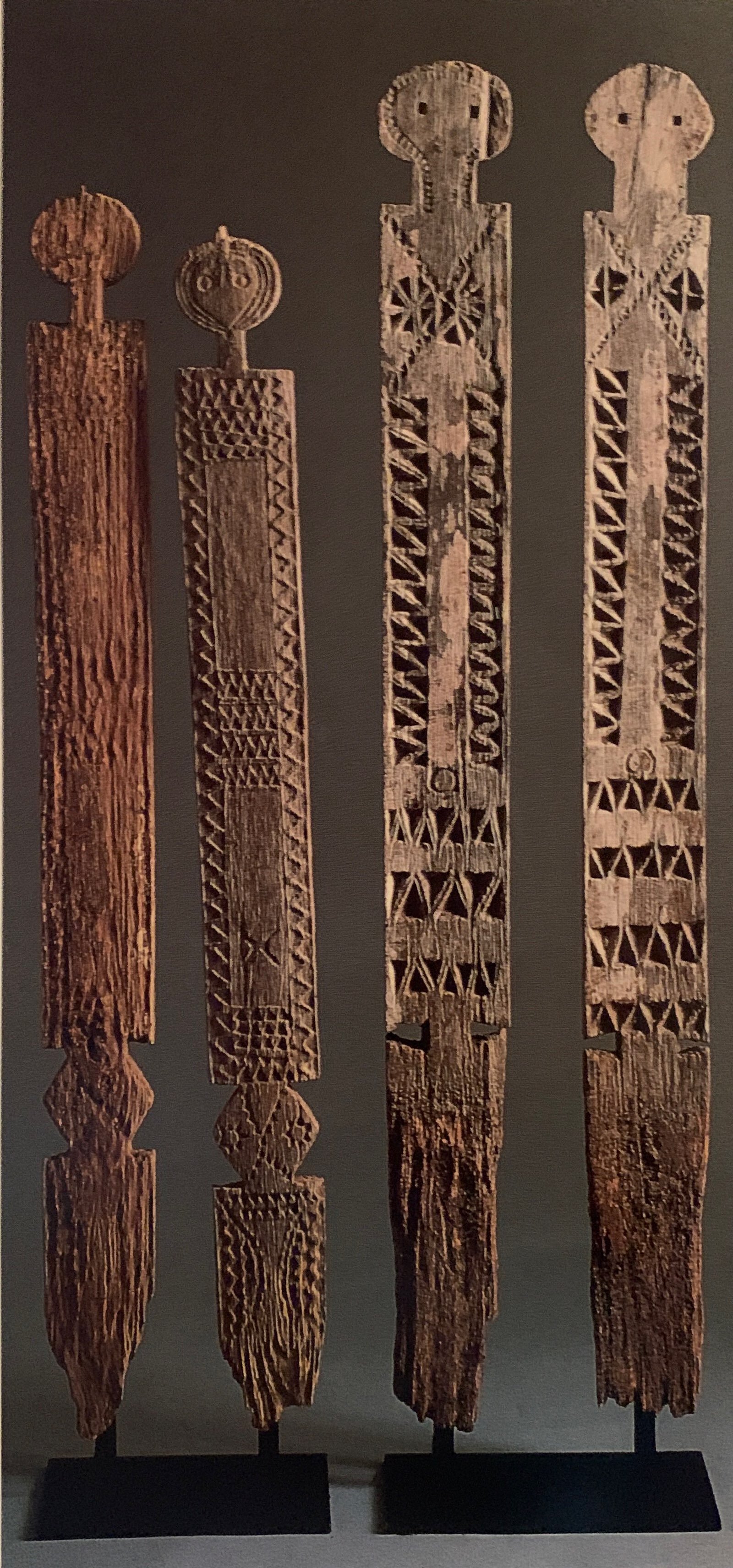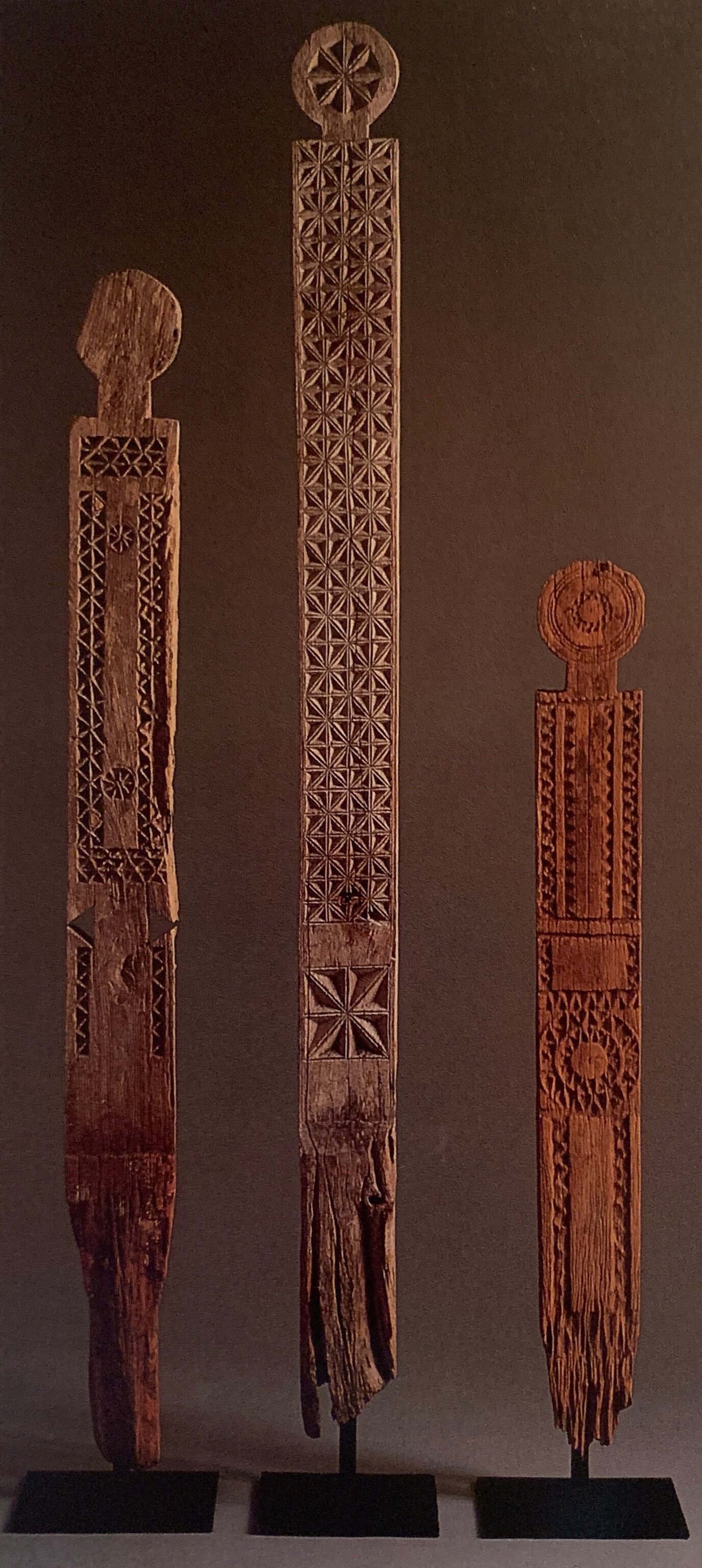The History of Vigango | Commemorative Sculptures of the Mijikenda Peoples of Kenya
Cover of Ernie Wolfe III’s definitive 82-page book on vigango, published in 1986 by Williams College Museum of Art with Professor Roy Sieber and David Parkin
Sculpted by artists/carvers from seven of the nine sub-groups (except for the Islamicized Digo and Duruma from the far south) that comprise the Mijikenda peoples of the Southeastern Kenya Coast, vigango (pl.; kigango = sing.) are one of the very few examples of large-scale, traditional, human-form, representational wooden sculpture to come from all of East Africa. These unique abstract anthropomorphic sculptures, often two-dimensionally carved, represent the spirits of members of the important Mijikenda all-male secret society, Chama cha Gohu, “the Society of the Blessed.”
Vigango do not mark graves. There is no physical relationship between the placement of a kigango and the body of the Gohu ancestor it represents; nor is there a temporal relationship between the time of the ancestor’s death, funeral, or burial and the erecting of a kigango in his memory.
A note of gratitude from the Kenyan Ambassador on behalf of President Daniel T. Arap Moi to Ernie Wolfe III on page 1 of 1979’s Arts of Kenya publication accompanying Wolfe’s exhibition featuring vigango at the Smithsonian Museum, Washington D.C.
Cover of Los Angeles Times HOME magazine, 1983, with vigango sculpture in living room
Vigango are classic ancestor veneration sculptures that represent the spirits of deceased Gohu Society members. Each kigango once served as a medium through which living members of this secret society (Gohu) communicated with other Gohu ancestors when they needed advice about reoccurring problems such as sickness, drought, or endemic disease. Erected in the center of the village, often near the chief’s wattle and daub house, these antenna-like forms were site-specific in their power. Vigango were only powerful as long as someone related to the deceased remembered the name of the Gohu spirit each sculpture represented, and their relatives continued to live nearby.
The Mijikenda, because of their centuries-old practice of slash-and-burn agriculture, were forced to shift village locations as the fertility of the soil surrounding their villages inevitably diminished. After moving from one village to another, the original vigango were left behind and abandoned in place. Their presence at the next village location was replaced with smaller figures without surface carvings called vibao (pl.; kibao = sing.), and the original vigango were rendered deactivated. Vibao inherited whatever power, spiritual or otherwise, was said to remain from their vigango progenitors, which were left behind and abandoned at the previous site. The erecting of a kibao at the new location completed the ritual deactivation of its kigango antecedent.
Back cover of Vigango: Commemorative Sculpture of the Mijikenda of Kenya (1986) by Ernie Wolfe III, photo credit: Ernie Wolfe III
A visual mnemonic is created in the carving of each kigango sculpture in order that it may be identified with a particular spirit, hence the individualized nature of each sculpture’s design and iconography. In general, the motifs on vigango are related to anatomical features. In almost all cases, both the waist notch and hips, and in many cases the umbilicus and heart, are also delineated. The vertical column of interlocking triangles that typically outline the front of the sculpture’s torso most likely relates to ribs. These so-called “chip-carved” triangular designs might be derived from the influence of architectural motifs seen in the doorways, etc. of the grand homes of the coastal Swahili, who have often served as the Mijikenda’s traditional trading partners and overlords. Some scholars have also said that these basically geometric motifs reflect the Mijikenda’s veneration for designs derived from nature.
The triangular chip-carved designs on vigango were often filled, alternately, with coral-based plaster and blackened charcoal or pitch appliqué, which disappeared over time in the open air. Many vigango are carved from hard woods from the family of lignum vitae, known in the kigiriama language as muhuhu, mwanga, and mtoro. When originally erected, most vigango faced west and were colorfully painted with organic pigment, or in later times, with commercially available oil-based house paint. However, with prolonged exposure to the elements, in most cases, this polychrome surface has given way to the bare eroded wood surface that we now associate with this form.
If you would like to inquire about any art you see on our site or in our collection, let us know and we would be happy to share more details or help you book an appointment!





